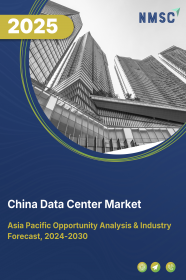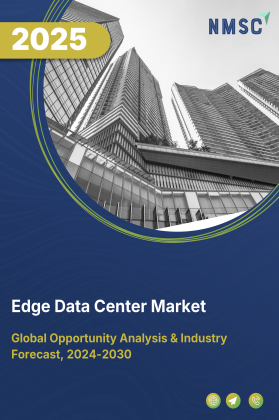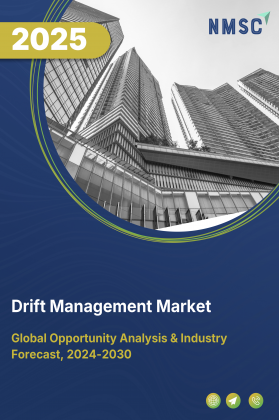
China Data Center Market by Infrastructure (Hardware, Software, and Services), by Type (Enterprise Data Centers, and others), by Data Center Rating (Tier I, and others), by Size (Small Data Centers, and others), by Power Capacity (<0.01 GW, 0.01-0.05 GW, 0.05-0.1 GW, 0.1-0.5 GW, and >0.5 GW), by Server Rack Density (<10kW, and others), by Data Center Redundancy (N+1, and others), by PUE Outlook (Less than 1.2, and others), and Others - Opportunity Analysis and Industry Forecast, 2024–2030
Industry: ICT & Media | Publish Date: 27-Oct-2025 | No of Pages: 210 | No. of Tables: 166 | No. of Figures: 111 | Format: PDF | Report Code : IC2437
China Data Center Market Overview
The China Data Center Market size was valued at USD 14.47 billion in 2023, and is predicted to reach USD 33.37 billion by 2030, at a CAGR of 12.7% from 2024 to 2030.
The data center market, also referred to as the network infrastructure market, encompasses the complete lifecycle of specialized infrastructure designed for hosting computing systems, spanning from initial planning to construction, operation, and ongoing maintenance. This infrastructure includes diverse components such as servers, storage systems, and networking gear, facilitating services such as cloud computing and connectivity solutions. Presently, the industry witnesses widespread adoption of cloud services, alongside the emergence of edge computing to mitigate latency issues.
Key trends within the sector include a growing emphasis on sustainability, heightened focus on cybersecurity, the integration of hybrid and multi-cloud approaches, and the impact of 5G networks. These trends underscore the industry's adaptation to meet the increasing demand for scalable, efficient, and secure data processing and storage solutions amidst the era of digital transformation. Projections by the United States International Trade Commission anticipate substantial growth in the data processing and storage China data center market, with estimates rising from USD 56 billion in 2020 to USD 90 billion by 2025.
Accelerating Digital Economy and AI-First Transformation Fuel Market Growth
China's digital economy is undergoing a profound transformation, led by aggressive national strategies that prioritize AI integration, cloud computing, and industrial digitalization. The "Digital China" and "Smart China" initiatives are fostering large-scale digital infrastructure development, especially in sectors like finance, manufacturing, e-commerce, and healthcare. These efforts have resulted in widespread adoption of cloud-native architectures and AI-driven platforms that demand high-performance computing and low-latency data access.
The explosive growth of generative AI in China, led by Baidu's Ernie Bot, Alibaba's Tongyi Qianwen, and Tencent’s Hunyuan model, is driving unprecedented compute requirements. This surge is boosting demand for AI-optimized data centers with high-density GPU clusters and advanced liquid cooling systems. Moreover, as 5G reaches full national deployment—with coverage in all prefecture-level cities by 2023—China is seeing a wave of edge computing deployments to power real-time analytics, autonomous driving, and smart infrastructure projects.
Enterprises are also aligning with China’s Personal Information Protection Law (PIPL), driving demand for in-country, compliant infrastructure to ensure data sovereignty. Together, these trends are positioning China’s data center sector as a critical enabler of its transition into a next-generation digital powerhouse.
Strategic Government Policies and Cross-regional Computing Initiatives Expand Market Scale
The Chinese government's policy interventions are a key driver of data center market expansion. Central to this is the "East Data, West Computing" program, a national strategy launched in 2022 to redistribute computing workloads from energy-strained eastern cities to energy-rich, lower-cost western regions such as Inner Mongolia, Gansu, Guizhou, and Ningxia. The initiative involves eight major computing hubs and 10 national data center clusters, expected to unlock over 1,200 MW of additional capacity.
Moreover, China’s "New Infrastructure" policy framework is channeling massive state and private investments into next-generation digital infrastructure, including green data centers, industrial internet platforms, and AI training clusters. Local governments are offering favorable land policies, tax rebates, and energy access guarantees to attract hyperscale operators and cloud service providers.
Provincial support in key hubs such as Hebei (Zhangjiakou), Jiangsu (Wuxi), and Sichuan (Chengdu) has already resulted in large-scale hyperscale campuses, backed by state-owned energy companies and telecom operators. These policies ensure that data center growth is aligned with national goals of economic resilience, technological self-sufficiency, and sustainability.
High Infrastructure Costs and Policy Complexity Limit Deployment Scale
Despite rapid growth, the China data center market faces several structural constraints. Land and energy costs in Tier 1 cities such as Beijing, Shanghai, and Shenzhen have surged, making greenfield development increasingly expensive. In these cities, strict energy efficiency requirements and limited power grid availability have capped new project approvals.
Power quotas and environmental impact assessments are tightly regulated by agencies such as the National Development and Reform Commission (NDRC), creating longer approval timelines and uncertainty for private developers. In regions like Beijing and Shanghai, new data centers must meet ultra-low PUE (Power Usage Effectiveness) thresholds—often below 1.3—and comply with local renewable energy procurement mandates, raising upfront capital costs.
Moreover, geopolitical sensitivities and heightened scrutiny over cross-border data flow have made international partnerships and equipment procurement more complex. These hurdles can deter foreign entrants and limit innovation velocity in certain segments of the market.
Edge Computing, 5G Integration, and Digital Industrial Zones Create New Growth Hubs
China’s full-scale 5G deployment and massive rollout of smart manufacturing zones under the “Industrial Internet” strategy are catalyzing the growth of edge data centers across second- and third-tier cities. Local governments in provinces such as Henan (Zhengzhou), Hunan (Changsha), and Anhui (Hefei) are actively promoting edge facility construction near industrial parks, smart factories, and logistics hubs.
The integration of modular edge data centers with 5G base stations—led by operators like China Mobile and China Unicom—is enabling support for real-time use cases like automated warehousing, AI-driven quality control, and connected vehicles. Municipal-level smart city initiatives are also increasing demand for decentralized infrastructure that supports video surveillance, traffic control, and emergency response systems.
This decentralized trend is creating new investment zones away from oversaturated Tier 1 cities, allowing developers to tap into underutilized land, cheaper power, and supportive policy environments.
Western Region Computing Hubs and Green Energy Alignment Diversify Growth Pathways
Western China is rapidly emerging as a major growth frontier for the country’s data center market. Locations such as Gui’an (Guizhou), Zhongwei (Ningxia), and Hohhot (Inner Mongolia) offer abundant land, favorable climate for natural cooling, and access to large-scale renewable power sources—primarily wind and solar.
The Chinese government has designated these regions as core nodes in the "East Data, West Computing" framework, supporting hyperscale builds with streamlined permitting, direct state subsidies, and access to ultra-high-voltage (UHV) power transmission lines. This alignment of green power capacity with digital infrastructure needs is making these areas attractive for hyperscalers focused on sustainable operations.
Major players such as Apple (via Guizhou Cloud Big Data), Tencent, and China Telecom have already commissioned or planned new campuses in these regions, many targeting PUE levels below 1.2. Innovations such as immersion cooling, AI-based thermal controls, and hydrogen-based backup systems are increasingly being piloted, making China a global leader in green data infrastructure experimentation.
Competitive Landscape
The key players operating in the China data center industry include China Telecom Corporation Limited, China United Network Communications Group, China Mobile International Limited (CMI), GDS Holdings Limited, Alibaba Cloud, 21Vianet Group (VNET), Huawei Technologies Co., Ltd., Chayora, Digital Realty, Equinix, Chindata Group, Tencent Cloud, BDx Data Center, JD Cloud (JD.com), NTT Global Data Centers Corporation and others.
China Data Center Market Key Segments
By Infrastructure
-
Hardware
-
IT Hardware
-
Servers
-
Storage Systems
-
Networking Equipment
-
-
Power Infrastructure Hardware
-
Uninterruptible Power Supplies (UPS)
-
Generators
-
Automatic Transfer Switches
-
Power Distribution Units (PDUs)
-
-
Mechanical Infrastructure Hardware
-
Computer-Room Air Conditioners (CRAC/CRA Units)
-
Chillers
-
Racks
-
Cable Management Systems
-
-
Safety & Security Hardware
-
Fire Suppression Systems
-
Physical Security Systems (CCTV, access controls)
-
-
-
Software
-
DCIM & Monitoring
-
Automation & Orchestration
-
Backup & Disaster Recovery
-
Security Software
-
Virtualization Software
-
Analytics & Reporting Software
-
Other Software
-
-
Services
-
Planning & Professional Services
-
Site & Building Design
-
System/Infrastructure Engineering
-
Professional Advisory (compliance, energy audits)
-
-
Integration & Deployment Services
-
Electrical & Mechanical Installation
-
Commissioning & Acceptance Testing
-
-
Operation & Support Services
-
Preventive & Corrective Maintenance
-
Facilities Management / Remote Monitoring
-
Support Services (helpdesk, onsite SLA support)
-
-
Hosting & Managed Services
-
Colocation & Cloud Hosting Services
-
Virtual/Private Hosting Platforms
-
-
By Type
-
Enterprise Data Centers
-
Colocation Data Centers
-
Cloud Data Centers
-
Hyperscale Data Centers
-
Edge Data Centers
-
Micro Data Centers
-
Others
By Data Center Rating
-
Tier I
-
Tier II
-
Tier III
-
Tier IV
By Size
-
Small Data Centers
-
Med-sized Data Centers
-
Large Data Centers
By Power Capacity
-
<0.01 GW (Small)
-
0.01-0.05 GW (Medium)
-
0.05-0.1 GW (Large)
-
0.1-0.5 GW (Hyperscale)
-
>0.5 GW (Mega-campus)
By Server Rack Density
-
<10kW
-
10-19kW
-
20-29kW
-
30-39kW
-
40-49kW
-
>50kW
By Data Center Redundancy
-
N (No Redundancy)
-
N+1 (Single-fault tolerant)
-
N+2 (Dual-fault tolerant)
-
2N (Full duplication)
-
2N+1 (Concurrently maintainable + extra spare)
-
3N/2N+2 (Multi-backup fault tolerant)
By PUE Outlook
-
Less than 1.2
-
1.2 - 1.5
-
1.5 - 2.0
-
Greater than 2.0
By Design Outlook
-
Traditional
-
Containerized
-
Modular
By End User
-
Cloud Service Provider
-
Technology Provider
-
Telecom
-
Healthcare
-
BFSI
-
Retail & E-commerce
-
Entertainment & Media
-
Government
-
Energy
-
Others
Key Players
-
China Telecom Corporation Limited
-
China United Network Communications Group
-
China Mobile International Limited (CMI)
-
GDS Holdings Limited
-
Alibaba Cloud
-
21Vianet Group (VNET)
-
Huawei Technologies Co., Ltd.
-
Chayora
-
Digital Realty
-
Equinix
-
Chindata Group
-
Tencent Cloud
-
BDx Data Center
-
JD Cloud (JD.com)
- NTT Global Data Centers Corporation
Report Scope and Segmentation
|
Parameters |
Details |
|
Market Size in 2023 |
USD 14.47 Billion |
|
Revenue Forecast in 2030 |
USD 33.37 Billion |
|
Growth Rate |
CAGR of 12.7% from 2024 to 2030 |
|
Analysis Period |
2023–2030 |
|
Base Year Considered |
2023 |
|
Forecast Period |
2024–2030 |
|
Market Size Estimation |
Billion (USD) |
|
Growth Factors |
|
|
Companies Profiled |
15 |
|
Market Share |
Available for 10 companies |
|
Customization Scope |
Free customization (equivalent up to 80 working hours of analysts) after purchase. Addition or alteration to country, regional, and segment scope. |
|
Pricing and Purchase Options |
Avail customized purchase options to meet your exact research needs. |

















 Speak to Our Analyst
Speak to Our Analyst

























